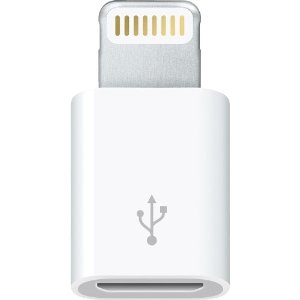
One of the downsides of upgrading to a new iPhone 5, iPod touch, iPad mini or iPad 4th generation device is that the traditional 30 pin connector that we’ve known for years has been replaced with a smaller “Lightning” plug. Initially Apple introduced a 30 pin to Lightning adapter and cable adapter. However, shortly thereafter they also released this very small Lightning to Micro USB adapter. What I like about this one in particular is that Micro USB cables and chargers are everywhere! Every other smartphone being sold today charges via Micro USB. So does my bluetooth headset, Jambox speaker and a variety of other gear I carry. With this small fingernail sized adapter I can use any of my existing cables/chargers to charge my iPhone 5 or iPad mini.
In my opinion all of these adapters and cables are overpriced, but it appears that the knockoffs either don’t work or are very poorly made. Until I find a good knockoff, I’ll keep buying the Apple branded adapters. You can get the Lightning to Micro USB adapter here.


A friend of mine told me about this great new adapter last week and I rushed out to get one right away. I have lots of Micro-USB cables at work so being able to charge my iPhone5 there without having to bring my Lightning charger in from home is very handy.
Thinking about buying one of these, hesitant about the price though, read somewhere that these things are more expensive per gram than gold!!!!
Too bad all micro-USB is good for is on a smartphone is charging the device.
The 30 pin dock connector was old (over a decade) and worked well in a mostly analog world. It allowed for applications that have been unheard of in the rest of the smart phone world. I have a medical device that monitors my blood glucose directly to my iPhone. There are many medical devices like this for iPod Touch or iPhone on the market. There are few to none for micro-USB.
The Lightning connector is an all digital connector with a smart chip embedded in that allows for things micro-USB can not do. There is a small CPU on the adapter. That’s why it cost $29.
An engineer breaks it down:
http://brockerhoff.net/blog/2012/09/13/boom-2/
http://brockerhoff.net/blog/2012/09/18/boom-a-follow-up/
http://brockerhoff.net/blog/2012/09/23/boom-pins/
I know how many people were upset when the industry changed from parallel and serial ports to USB. Lots of people had old printers that would not work with new computers that had USB only. Or they had old computers without USB ports that wouldn’t work with new USB only printers. I remember buying a $50 USB to parallel cable for my old laser printer to work with a new Dell desktop.
This is technology. Stuff changes.
The chips in the adapter are “… taking the digital audio and converting it into the analog signal that the 30 pin delivers.”
http://www.chipworks.com/blog/recentteardowns/2012/10/18/inside-the-apple-lightning-to-30-pin-adapter/